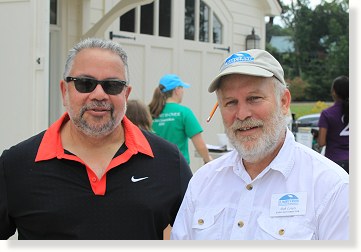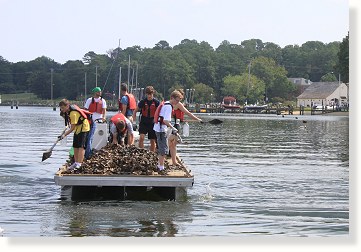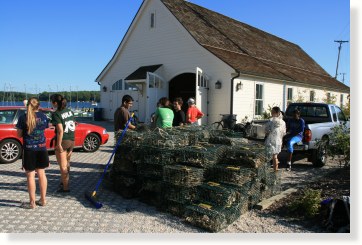RESOURCES:
Marylanders Grow
Oysters in the
St. Mary's River
RESEARCH:
The Relation of
Sedimentation to
Growth Rate
in St. Mary's River
BOEING AWARDS $13,780 TO RESTORE OYSTERS IN ST. MARY'S RIVER
DECEMBER 2010—
Boeing's Oscar Ocasio and SMRWA's Bob Lewis* * * * * * * * *
500,000 OYSTERS PLANTED
ST. MARY'S COLLEGE WATERFRONT - August 28, 2010—Incoming first-year students planted 500,000 oysters in the St. Mary's River Sanctuary. The project was funded by Boeing Global Corporate Citizenship. Boeing community representative, Oscar Ocasio, was impressed with the effort by the students and goals of the program."This is really going to make a difference. Corporate is very impressed with this program," said Ocasio.
Students unloaded oysters from a truck, loaded them on to a barge, traveled to the planting site about 1/4 mile away, and spread the oysters on an existing, but depleted, oyster bar. SMRWA boards members Richard Holden and Pat Murphy carried media personnel and spectators to the planting site in their private vessels.
* * * * * * * * *
MGO OYSTER CAGE DISTRIBUTION
ST. MARY'S COLLEGE WATERFRONT - Sept. 18, 2010—Marylanders Grow Oysters program volunteers gathered to pick up cages of baby oysters to take home to hang on their docks for the winter where they will care for the infants through their first vulnerable year of life.
The Marylanders Grow Oysters in the St. Mary's River program expanded in September 2010 to 100 dock owners and 650 cages hosting approximately 175,000 spat. In June 2011, the oysters will be planted into the St. Mary's River oyster sanctuary where they can mature and reproduce. Read more.
* * * * * * * * *
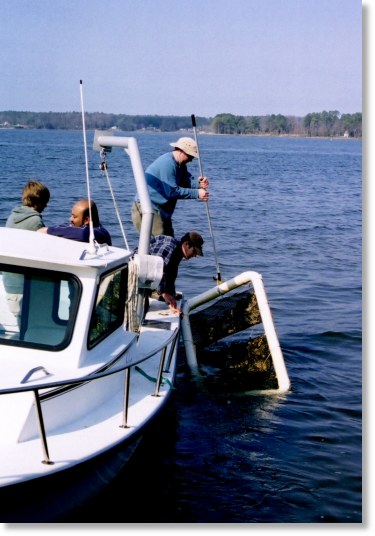
Oyster Restoration in St. Mary’s River
Abstract: Project sought to define pathways toward increasing oyster biomass and commercial harvests in the St. Mary’s River by means of strategic placement and management of farmed and selectively-bred oysters, and measure the results of these efforts. By forming an important cadre of new oyster farmers, we also intended to generate greater citizen demand for stable or improving water quality and more official concern for environmental degradation within a bellwether watershed. More specifically, we assessed the ability of farmed, selectively bred native oysters raised in bags on floats to achieve progress toward Maryland oyster restoration goals relative to wild oyster performance employing traditional oyster-reef methods. We also planned to assess the extent to which impacts of farmed oyster floats on water quality and aquatic biodiversity in the river can be measured. Analysis of data carefully gathered during the year-long duration of the project, and public dissemination of this information, largely achieved these goals.
DOWNLOAD THE FULL REPORT - PDF FORMAT [349 KB]
WATCH THE VIDEO TEASER ON YOU-TUBE
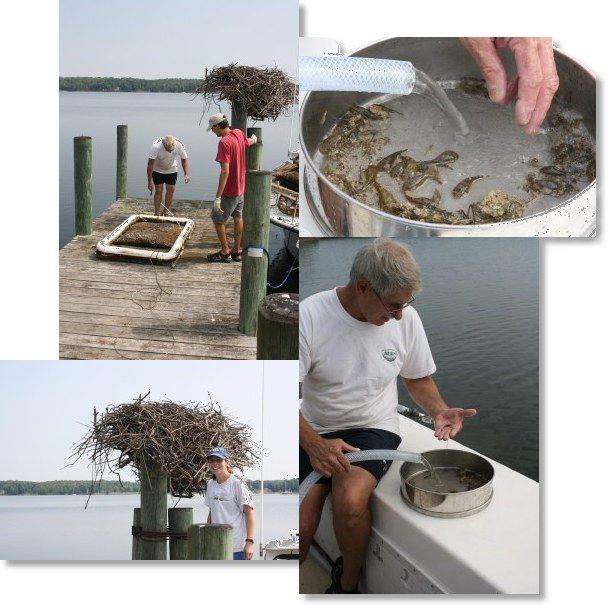
Top: Project Coordinator Henry Bush hoists an oyster float on board for one of many periodic surveys. Collage - clockwise from top left: Science Advisor Bob Paul and staff Kevin Boyle survey oyster float on private pier. Close up image depicting diversity of oysetr float community. Bob Paul counts visable animals while Captain Amy Drohan (out of view) records data (smaller animals are identified and counted in the laboratory). Captain Amy Drohan poses in fron of a large and habited osprey nest on private pier.
